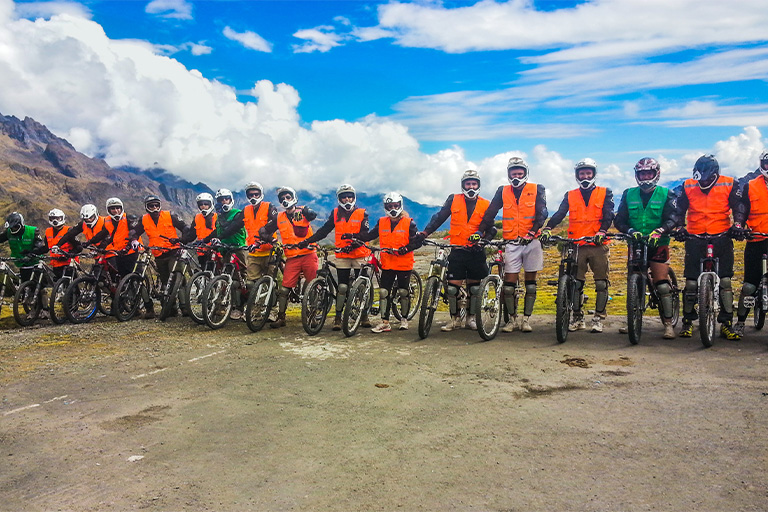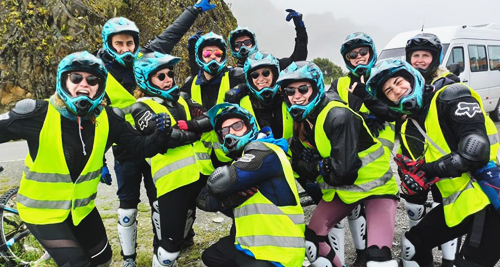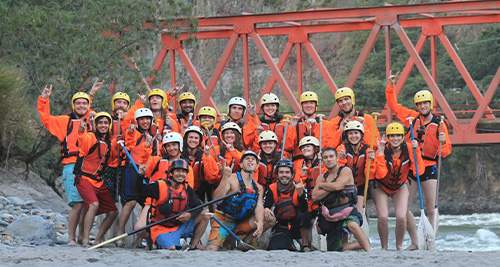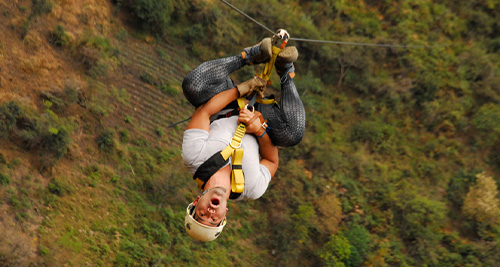
 3 Days / 2 Nights
3 Days / 2 Nights  From US$ 350,00 per person
From US$ 350,00 per person  Difficulty:
Low
Difficulty:
Low  Max. Altitude:
14,273 FT / 4,350 M
Max. Altitude:
14,273 FT / 4,350 M  7.4 MILES / 12 KM
7.4 MILES / 12 KM Inca jungle trail is a multi-activity tour to Machu Picchu and one of the most enjoyable tours you can find in the Cusco region. This adventure tour offers you biking, rafting, zip line, and trekking. It also takes you to different local restaurants serving delicious food with ingredients from the local region. Finally takes you to the beautiful archeological site of Machu Picchu.

All way down, enjoy mountain biking from 14,271 FT (4350 M) to 8,202 FT(2500 M).

Join the river rafting tour, which includes class 2 and 3 rapids in a warm jungle area.

Enjoy zip-lining, consisting of 8,200 FT of cables divided into five sections.
Cusco - Santa María village : Biking 53Km - (Rafting optional: 100 Soles from April- november) - Santa Teresa
Santa Teresa - Hidroelectric - Aguas Calientes
Machu Picchu - Ollantaytambo - Cusco

Day 1: Cusco – Santa María village : Biking 53Km (Rafting optional: 100 Soles from April- november) – Santa Teresa
We will go to pick you up from your respective hostel. After collecting all the group we will leave Cusco and drive an hour and a half across the spectacular Chinchero plateau and through the Sacred Valley to Ollantaytambo. We will stop at a small local restaurant where you can refresh yourself, get a quick meal or snack, and buy anything you may have forgotten to buy in Cusco. After, we have go back in the bus and drive another hour and a half to Abra Malaga (Malaga pass) at 4,350 m.a.s.l. There we will provide you all equipment you will need (bike, gloves, elbow pads, knee pads, and helmet), followed by a briefing by our experienced tour guide. Then we mount up for a fun ride all way down hill to Santa Maria at 1,430 m.a.s.l. On the way you will see a lot different landscapes, panoramic views and different micro-climates.We will arrive approximately 4-3 hours, in time for our lunch!
After lunch in Santa Maria we have a free afternoon to rest or explore the village. As an optional highlight you can choose to join the river rafting tour (100 soles). This will take you on quillabamba river for approximately 2hrs or 25 km and includes class 2 and class 3 rapids.
In the evening we drive from Santa Maria to Santa Teresa for 1hrs. As an optional extra, take a local van to Cocalmayo to soak in the natural hot springs. Then we spend the night in Santa Teresa.
Day 2: Santa Teresa – Aguas Calientes
We will start at around 6 am. After a great breakfast we will get ready to continue walking to Hidroelectrica and then to aguas calientes.
There is an option in Santa Teresa to do zip line, all participants will be divided into 2 groups – one who booked zip line and the other who did not. Those of you who reserved zip line will be transported to the place where will be organized this activity for about 3 hours approximately. This group will be taken by bus to the area known as the Hidroelectrica. The rest of the group will continue the trek for approx. 3 hrs. more through the valley until reaching the Hidroelectrica, where the entire group will get together again. Here all of you will have a lunch. After a short break we will continue walking along the train way and enjoying beautiful landscapes. This part will take approx. 3 hrs. We will arrive to the town of Aguas Calientes, around 4 pm. Here, in the hostel with hot water, wi-fi, you will spend the last third night. In the evening we will meet ll together in the restaurant, where will be waiting for you delicious dinner. You will also have a briefing with the guide about the fourth day and Machu Picchu.
Day 3: Aguas Calientes – Machu Picchu – Aguas Calientes – Ollantaytambo – Cusco
We will wake up, at 4:00 am, in order to start trekking up the mountain to Machu Picchu in time to catch the sunrise at the top. It will take approximately 1hour and 20 minutes (or by the bus up 20 minutes). Also you have the option to buy your bus ticket one night before if you don’t want this at the last minute. When we first arrive, our guide will take us on a 2 hour tour around the ruins, enlightening us about the ancient City that was once so vibrantly alive, and enriching us with the Inca history. There is much information that our guide can teach us, about all that we have learned about citadel so far.
After the guided portion of the tour, you will have some free time to explore the ruins by your self. If you want to climb Huayna Picchu, a very popular climb with spectacular views, we recommend you to book preferably three months beforehand. (There is daily limit of 400 persons per day allowed to climb, so pre-book if you don’t want to miss out. Cost: $25) The round trip walking to the peak of Huayna Picchu is about an hour and a half. It is definitely worth it for the stunning views from the top! As an alternative to the Huayna Picchu climb you can choose to visit Machu Picchu Mountain which gives the ancient Inca townsite its name. This is a new option that lets you see Machu Picchu archeological site from the highest peak. It is less crowded so you don’t have to book early. Cost: $20)
You will need to descend to Aguas Calientes in time to catch the train back to Ollantaytambo.
Train from Machupicchu to Ollantaytambo is about 1 hour 45 minutes, then you need to go out of train station to get bus , after one hour and a half you will be drop in Cusco.
Not Included
Shared service price: $.350.00.
Important: Shared service price is only available with agreement passengers to share this service with other travelers (Group site 12 – 19 People approx.)
Private service price: $.600.00. (based on two people)
Included all mentioned before
Group size upon your request, for people who need a personalize and exclusive service
Departure day is according to passenger request
Price for bigger groups are according to group size
Do you need to book a Private tour? Book here.
What you should bring
Important to know!
Not appropriate for
What is the Inca Jungle Trail?
The Inca Jungle Trail is an alternative route to Machu Picchu that combines hiking, biking, and other outdoor activities. It is named for the fact that it passes through the jungle regions of Peru where the Inca civilization once thrived.
The trail starts in the town of Cusco and follows a route that takes travelers through the Andes mountains, past small villages and ancient Inca ruins, and through lush rainforest. Along the way, hikers and bikers can take part in a range of activities, including zip-lining, hot springs, and rafting.
The Inca Jungle Trail is known for its diverse terrain and stunning scenery, and it offers a unique way to experience the beauty and history of the region. The trail typically tree to five days to complete, and it is a popular option for those looking for a more adventurous and off-the-beaten-path route to Machu Picchu.
How long is the Inca Jungle Trail?
The length of the Inca Jungle Trail can vary depending on the specific route taken and any side trips or activities included along the way. Generally, the trail is around 60 to 80 kilometers (37 to 50 miles) long, and it usually takes four to five days to complete. The distance covered by hiking or biking each day can also vary, with some days covering more ground than others. The Inca Jungle Trail is considered a challenging trek due to its varied terrain and activities, so it is important to be prepared physically and mentally before embarking on this adventure.
What is the difficulty level of the Inca Jungle Trail?
The Inca Jungle Trail is considered a moderate to challenging trek, with a variety of areas and activities that require a reasonable level of physical fitness.
What is the altitude of the Inca Jungle Trail?
The altitude of the Inca Jungle Trail varies along the route and depends on the specific section you are on. The highest point of the trek is Abra Malaga Pass, which is located at an altitude of 4,316 meters (14,160 feet) above sea level. However, most of the trek takes place at lower altitudes, ranging from around 2,000 to 3,500 meters (6,500 to 11,500 feet) above sea level.
It’s worth noting that the Inca Jungle Trail involves some significant altitude changes, as you will be descending from the high Andean mountains to the lush tropical jungle. As such, it’s important to be prepared for changes in temperature and altitude throughout the trek.
Is the Inca Jungle Trail open year-round?
The Inca Jungle Trail is generally open year-round, but the best time to do the trek is during the dry season from May to September. During this period, the weather is generally dry and sunny, making hiking and other outdoor activities more enjoyable. However, it’s also the peak season, so the trail can be crowded, and it’s important to book in advance.
.When is the best time of year to do the Inca Jungle Trail?
The best time of year to do the Inca Jungle Trail is during the dry season, which runs from May to November. During this period, the weather is generally dry, sunny, and comfortable, making hiking and other outdoor activities more enjoyable. The dry season is also the peak season for tourism, so it’s important to book your trip in advance.
That being said, the shoulder months of April and October can also be good times to do the trek, as the weather is generally still dry, and there are fewer tourists on the trail. The shoulder season can offer a quieter and more relaxed experience, with fewer crowds and more availability for accommodations and tour bookings.
The wet season, which runs from December to March, can be more challenging due to heavy rains, It’s important to be prepared for wet conditions if hiking during this season.
What is the maximum altitude of the Inca Jungle Trail?
The highest point of the Inca Jungle Trail is Abra Málaga pass, which is located at an altitude of approximately 4,316 meters (14,160 feet) above sea level. te gear and medications if necessary.
How fit do I need to be to do the Inca Jungle Trail?
The Inca Jungle Trail involves a variety of physical activities, including hiking, biking, and zip-lining. While you don’t need to be an elite athlete to complete the trek, it’s important to have a reasonable level of physical fitness to enjoy the experience and avoid injury.
You should be able to comfortably walk for several hours at a time, including uphill and downhill sections. You should also have good balance and coordination for the biking and zip-lining portions of the trek. Additionally, you should be prepared to cope with the effects of high altitude, such as shortness of breath and fatigue.
It’s recommended to train for the Inca Jungle Trail by incorporating cardio and strength training exercises into your fitness routine, as well as practicing hiking and biking on similar terrain. It’s also important to acclimate to the altitude by arriving in Cusco or the surrounding area a few days before the trek to allow your body to adjust.
If you have any specific medical conditions or concerns, it’s recommended to consult with a doctor before embarking on the Inca Jungle Trail. It’s always better to err on the side of caution and choose an itinerary or tour operator that matches your fitness level and abilities.
Is there electricity on the Inca Jungle Trail?
Yes, there is electricity on every camping site or small town you will stop for overnight.
Can I request vegetarian or other special meals on the Inca Jungle Trail?
On the Inca Jungle Trail are able to accommodate special dietary requirements, including vegetarian, vegan, gluten-free, or other special meal requests. It’s important to inform your tour GUIDE of your dietary requirements well in advance of your trek, so that they can make the necessary arrangements and ensure that you’re able to enjoy your meals during the tour.
Do I need to bring water purification tablets for the Inca Jungle Trail?
It’s not necessary to bring water purification tablets for the Inca Jungle Trail However, it’s always a good idea to check with your tour guide before departing on the trek to confirm what kind of water will be available and whether you need to bring any additional equipment or supplies.
Do I need to bring rain gear for the Inca Jungle Trail?
Yes, it’s recommended to bring rain gear for the Inca Jungle Trail, especially if you’re trekking during the rainy season. The region is known for its frequent and sometimes heavy rain showers, particularly from November to March. Even during the dry season, there can still be occasional rain showers.
Are there restrooms on the Inca Jungle Trail?
Yes, there are restrooms along the Inca Jungle Trail, although they may be basic and sometimes require a small fee to use. Many of the campsites and lodges along the trail have restroom facilities, which may include flush toilets or basic pit toilets.
What kind of transportation is used on the Inca Jungle Trail?
The Inca Jungle Trail involves various modes of transportation, including private vans, public buses, and bicycles. Depending on the specific itinerary and tour company you choose, you may also have the option to take a train for part of the journey.
Is there a weight limit for the zip-line on the Inca Jungle Trail?
Yes, there is typically a weight limit for the zip-line on the Inca Jungle Trail. The exact weight limit can vary depending on the tour company or operator, but it is usually in the range of 120-150 kg (265-330 lbs). This is because the zip-line equipment is designed to support a certain amount of weight, and exceeding the limit can compromise safety and put riders at risk.
Need more information about Inca Jungle? read: Inca Jungle Trail: Your Ultimate Guide to an Adventurous Trek in Peru

Search